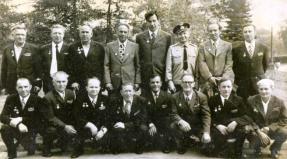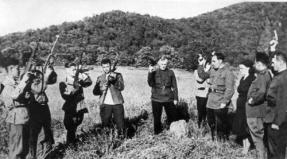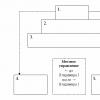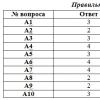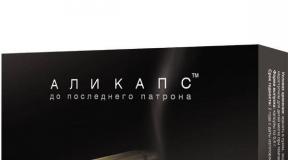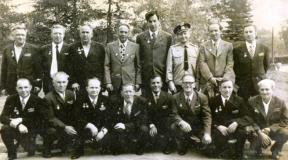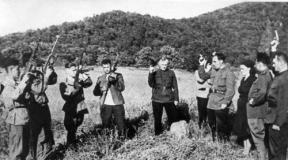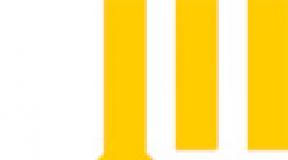Test task in the Russian language on the topic: “Punctuation marks in a complex sentence. Course: Preparation for the Unified State Exam in the Russian language, Distance course. Preparation for the Unified State Exam in the Russian language: A22-A25 Test task in the Russian language on the topic: “Punctuation marks in
Place all punctuation marks: indicate the number(s) in whose place(s) there should be a comma(s) in the sentence.
In his parents’ house, everything was as before (1) and (2) if Volodya seemed to have the home space as if it had narrowed (3), it was only because (4) that during the years of absence he had matured and grown a lot.
Explanation (see also Rule below).
Let's give the correct spelling.
In his parents’ house everything was the same, and if Volodya seemed to have narrowed his home space, it was only because during the years of absence he had matured and grown a lot.
Comma 1 separates the sentences “Everything was the same in the parents’ house” and “if it seemed to Volodya that the home space seemed to have narrowed.”
Commas 3 and 4 are placed before the subordinate clauses “this is only because” and “that during the years of absence he has matured and grown a lot.”
Commas should be in places 1, 3 and 4.
Answer: 134
Rule: Task 20. Punctuation marks in sentences with different types of connections
TASK 20 Unified State Exam. PUNCTUATION MARKS IN SENTENCES WITH DIFFERENT TYPES OF CONNECTION
In task 20, students must be able to place punctuation marks in a complex sentence consisting of 3-5 simple ones.
This challenging task tests the graduate’s ability to apply the following knowledge in practice:
1) at the level of a simple sentence:
Understanding that there is no sentence without a basis;
Knowledge of the features of the basis of one-part sentences (impersonal, etc.)
Understanding that in a simple sentence there can be homogeneous predicates and subjects, punctuation marks between which are placed according to the rules of homogeneous members.
2) at the level of a complex sentence:
The ability to determine the main and subordinate clauses in the composition of the IPP on the issue;
The ability to see conjunctions (conjunctive words) in subordinate clauses;
The ability to see index words in the main
The ability to see homogeneous subordinate clauses, in which punctuation marks are placed in the same way as homogeneous clauses.
3) at the level of a complex sentence:
The ability to see parts of the BSC and separate them with a comma. There is no common minor term in this task.
4) at the level of the entire proposal as a whole:
The ability to see those places in a sentence in which two conjunctions meet: there may be two subordinating conjunctions or a coordinating and subordinating conjunction.
Let's collect all the basic punctuation rules that are important when completing the task and number them for convenience.
| BP 6 If in a complex sentence there are coordinating and subordinating conjunctions nearby (And and ALTHOUGH, AND and HOW, AND and IF, BUT and WHEN, AND and THAT, etc.), then you need to find out if after the subordinate part there are correlative words THAT, SO or another coordinating conjunction (A, BUT, HOWEVER, etc.). A comma is placed only when these words are missing after the subordinate clause. For example: [Curtain rose], and, (as soon as the audience saw their favorite), [the theater shook with applause and enthusiastic screams] For example: Compare: and (as soon as the public saw their favorite) So the theater trembled with applause and enthusiastic shouts]. and, (although her words were familiar to Saburov), [they suddenly made my heart ache]. [The woman talked and talked about her misfortunes], and (although her words were familiar to Saburov), But |
[they suddenly made my heart ache].
As you can see, rules 5 and 6 are very similar: we choose either to write TO (BUT...) or to put a comma.
Let's consider the proposals from the RESHUEGE database and the algorithm for working on the proposal. [Claim](1) what? ( What Brazilian carnivals delight and fascinate)(2)(3) (And When (4) when? That convinced yourself (5) of what? ( how much
the eyewitnesses were right).
1. Let's highlight the basics.
1- Affirm (one-part, predicate)
2- carnivals delight and fascinate
3- we saw
4- convinced yourself
5- eyewitnesses are right
2. We highlight conjunctions and correlative words. Please note that there are AND and WHEN nearby and that there is THAT.
([Claim](1) what? ( 3. We mark subordinate clauses: we put all sentences in which there are subordinating conjunctions in parentheses.
(And Brazilian carnivals delight and fascinate)
(convinced yourself (5) of what? ( how much
we saw its unique bright beauty for the first time)
4. We establish which subordinate clauses belong to the main ones. To do this, we pose questions from the main ones to the supposed subordinate ones. [Claim](1) what? ( Brazilian carnivals delight and fascinate). 1 component found. Comma 1 is placed according to rule 4 [ = ], (which is = and =).
There are two subordinate clauses left and one without a subordinating conjunction. We check whether it is possible to ask questions from him.
[(4) when? convinced yourself] when? ( And Brazilian carnivals delight and fascinate)
[convinced yourself] of what? ( convinced yourself (5) of what? ( the eyewitnesses were right). The second component has been found. Commas 4 and 5 are placed according to rule 4.
(when - =), [then- = ], (how much - =) Two different subordinate clauses to one main clause, a clause of time very often stands BEFORE the main clause.
Components 1 and 2 are connected by the coordinating conjunction AND into one complex sentence. This is comma 2.
Scheme: |[ = ], (what- = and =)|, and |(when - =), [then- = ], (as far as - =)|
It remains to find out whether a comma is needed 3. Between AND and WHEN, according to rule 6, a comma is not needed, since TO is located after the subordinate clause.
\ Documentation \ For teachers of Russian language and literatureWhen using materials from this site - and placing a banner is MANDATORY!!!
The Russian language test was prepared by: Natalya Ivanovna Pakhova, teacher of Russian language and literature, Municipal Budget Educational Institution OG No. 25, Arkhangelsk, email: [email protected]
Each task can have 1 correct answer.
A1. Provide the correct explanation for the punctuation in the sentence.
A fiery thread () flashed and the dense mixed forest was instantly illuminated by the light of a bright red flame.
A2. Provide the correct explanation for the punctuation in the sentence.
Leonardo da Vinci, in “The Dispute between the Painter and the Poet,” asserted the advantages of painting over poetry () and many contemporaries shared his point of view.
- A simple sentence with homogeneous members, before the conjunction and no comma is needed.
- Complex sentence, a comma is needed before the conjunction AND.
- Complex sentence, before the conjunction And there is no need for a comma.
- A simple sentence with homogeneous members, a comma is needed before the conjunction AND.
A3. Provide the correct explanation for the punctuation in the sentence.
There were frosty morning performances () and a snowy footprint was clearly printed on the pale grass.
- A simple sentence with homogeneous members, before the conjunction and no comma is needed.
- Complex sentence, before the conjunction And there is no need for a comma.
- Complex sentence, a comma is needed before the conjunction AND.
- A simple sentence with homogeneous members, a comma is needed before the conjunction AND.
A4. Provide the correct explanation for the punctuation in the sentence.
Silence in the forest () and among the silence - only the voice of the cuckoo.
- A simple sentence with homogeneous members, before the conjunction and no comma is needed.
- Complex sentence, before the conjunction And there is no need for a comma.
- A simple sentence with homogeneous members, a comma is needed before the conjunction AND.
- Complex sentence, a comma is needed before the conjunction AND.
A5. Provide the correct explanation for the punctuation in the sentence.
For an indifferent person, life quickly loses color () and he is left alone with his well-being.
- A simple sentence with homogeneous members, before the conjunction and no comma is needed.
- Complex sentence, before the conjunction And there is no need for a comma.
- Complex sentence, a comma is needed before the conjunction AND.
- A simple sentence with homogeneous members, a comma is needed before the conjunction AND.
A6. Provide the correct explanation for the punctuation in the sentence.
The light of the moon had already faded () and there was a whiff of dampness in the air.
- A simple sentence with homogeneous members, before the conjunction and no comma is needed.
- Complex sentence, before the conjunction And there is no need for a comma.
- A simple sentence with homogeneous members, a comma is needed before the conjunction AND.
- Complex sentence, a comma is needed before the conjunction AND.
A7. Which answer option correctly indicates all the numbers that should be replaced by commas in the sentence?
For a long time (1) whales (2) to observe (3) which (4) few had previously been able to (5) were considered fish.
- 2,3,4
A8. Which answer option correctly indicates all the numbers that should be replaced by commas in the sentence?
Animal thinking (1) provides the ability to immediately react correctly to a new situation (2) to resolve (3) which (4) there is no ready-made solution.
A9. Which answer option correctly indicates all the numbers that should be replaced by commas in the sentence?
In “Dead Souls” (1) Gogol followed the principles of that critical direction (2) which he himself gave a description (3) in one of the chapters of the poem.
A10. Which answer option correctly indicates all the numbers that should be replaced by commas in the sentence?
Biologists (1) each of whom (2) studies a specific group of marine organisms (3) go out into the ocean on huge research vessels.
A11. Which answer option correctly indicates all the numbers that should be replaced by commas in the sentence?
Any plant or garden sculpture (1) whose unusual shape (2) (3) amazes the imagination (4) attracts the attention of visitors.
A12. Which answer option correctly indicates all the numbers that should be replaced by commas in the sentence?
Mitya often simply admired his sister (1) and (2) even when he had to listen to her complaints that (3) she looked bad after night shifts in the hospital (4) Lyubasha seemed beautiful to him.
- 1,2,4
- 1,2,3,4
A13. Which answer option correctly indicates all the numbers that should be replaced by commas in the sentence?
Polina came out to the guests on the open veranda (1) and (2) while the ladies enthusiastically expressed admiration for her elegant outfit (3) she thought about (4) how nice it would be to be away from this boring empty bustle.
- 1,2,3,4
- 1,3,4
A14. Which answer option correctly indicates all the numbers that should be replaced by commas in the sentence?
In his parents’ house, everything was as before (1) and (2) if Volodya seemed to have the home space as if it had narrowed (3), it was only because (4) that during the years of absence he had matured and grown a lot.
- 1,2,3,4
- 1,3,4
- 2,3,4
A15. Which answer option correctly indicates all the numbers that should be replaced by commas in the sentence?
According to the calendar, we arrived in Boldino at the same time as the poet (1) but (2) if we take into account the difference between the new and old style (3) then ten days earlier (4) and the color green still reigned everywhere in nature.
- 1,2,3
- 1,2,3,4
- 1,3,4
A16. Which answer option correctly indicates all the numbers that should be replaced by commas in the sentence?
In any role, a talented actor feels free and natural (1) and (2) when he expresses the character of his hero on stage (3) he usually reaches the full feeling (4) that he is that same hero.
- 1,2,3,4
- 1,3,4
A17. A colon in place of the blank must be placed in the sentence
- There was no money left _ I went to public service.
- Only now I noticed that lemons and oranges bloom fragrantly in our yard, and the sea smells better than all the aromas in the world.
- In exchange for wool, livestock, barley, they received cedar wood, semi-precious stones, mother-of-pearl, and gold.
A18. Someone else's speech is incorrectly formatted in a sentence
- “This is painful!” - the artist muttered through his teeth and jumped up.
- Goethe once said that there are books from which “you can learn about everything and understand nothing.”
- According to the artist Karl Bryullov: “Art begins where it begins a little.”
A19. A colon in place of the blank must be placed in the sentence
- A number of coincidences, which cannot be called random, convinced that the found remains belong to an ancient Greek warrior.
- Among the public buildings, the famous basilica stood out - where there was a court and a shopping center.
3. Five minutes have passed for a long time _ no gateway was visible.
A20. Which sentence contains a dash? (no punctuation marks).
- You are like a dove.
- You could already feel winter in everything, with a light frost on the short days.
- The Yakut horse is undemanding.
- When we get to the place there will be rest.

Test task in the Russian language on the topic: “Punctuation marks in a complex sentence”
Liked? Please thank us! It's free for you, and it's a big help to us! Add our website to your social network:
Place all punctuation marks: indicate the number(s) in whose place(s) there should be a comma(s) in the sentence.
In his parents’ house, everything was as before (1) and (2) if Volodya seemed to have the home space as if it had narrowed (3), it was only because (4) that during the years of absence he had matured and grown a lot.
Explanation (see also Rule below).
Let's give the correct spelling.
In his parents’ house everything was the same, and if Volodya seemed to have narrowed his home space, it was only because during the years of absence he had matured and grown a lot.
Comma 1 separates the sentences “Everything was the same in the parents’ house” and “if it seemed to Volodya that the home space seemed to have narrowed.”
Commas 3 and 4 are placed before the subordinate clauses “this is only because” and “that during the years of absence he has matured and grown a lot.”
Commas should be in places 1, 3 and 4.
Answer: 134
Rule: Task 20. Punctuation marks in sentences with different types of connections
TASK 20 Unified State Exam. PUNCTUATION MARKS IN SENTENCES WITH DIFFERENT TYPES OF CONNECTION
In task 20, students must be able to place punctuation marks in a complex sentence consisting of 3-5 simple ones.
This challenging task tests the graduate’s ability to apply the following knowledge in practice:
1) at the level of a simple sentence:
Understanding that there is no sentence without a basis;
Knowledge of the features of the basis of one-part sentences (impersonal, etc.)
Understanding that in a simple sentence there can be homogeneous predicates and subjects, punctuation marks between which are placed according to the rules of homogeneous members.
2) at the level of a complex sentence:
The ability to determine the main and subordinate clauses in the composition of the IPP on the issue;
The ability to see conjunctions (conjunctive words) in subordinate clauses;
The ability to see index words in the main
The ability to see homogeneous subordinate clauses, in which punctuation marks are placed in the same way as homogeneous clauses.
3) at the level of a complex sentence:
The ability to see parts of the BSC and separate them with a comma. There is no common minor term in this task.
4) at the level of the entire proposal as a whole:
The ability to see those places in a sentence in which two conjunctions meet: there may be two subordinating conjunctions or a coordinating and subordinating conjunction.
Let's collect all the basic punctuation rules that are important when completing the task and number them for convenience.
| BP 6 If in a complex sentence there are coordinating and subordinating conjunctions nearby (And and ALTHOUGH, AND and HOW, AND and IF, BUT and WHEN, AND and THAT, etc.), then you need to find out if after the subordinate part there are correlative words THAT, SO or another coordinating conjunction (A, BUT, HOWEVER, etc.). A comma is placed only when these words are missing after the subordinate clause. For example: [Curtain rose], and, (as soon as the audience saw their favorite), [the theater shook with applause and enthusiastic screams] For example: Compare: and (as soon as the public saw their favorite) So the theater trembled with applause and enthusiastic shouts]. and, (although her words were familiar to Saburov), [they suddenly made my heart ache]. [The woman talked and talked about her misfortunes], and (although her words were familiar to Saburov), But |
[they suddenly made my heart ache].
As you can see, rules 5 and 6 are very similar: we choose either to write TO (BUT...) or to put a comma.
Let's consider the proposals from the RESHUEGE database and the algorithm for working on the proposal. [Claim](1) what? ( What Brazilian carnivals delight and fascinate)(2)(3) (And When (4) when? That convinced yourself (5) of what? ( how much
the eyewitnesses were right).
1. Let's highlight the basics.
1- Affirm (one-part, predicate)
2- carnivals delight and fascinate
3- we saw
4- convinced yourself
5- eyewitnesses are right
2. We highlight conjunctions and correlative words. Please note that there are AND and WHEN nearby and that there is THAT.
([Claim](1) what? ( 3. We mark subordinate clauses: we put all sentences in which there are subordinating conjunctions in parentheses.
(And Brazilian carnivals delight and fascinate)
(convinced yourself (5) of what? ( how much
we saw its unique bright beauty for the first time)
4. We establish which subordinate clauses belong to the main ones. To do this, we pose questions from the main ones to the supposed subordinate ones. [Claim](1) what? ( Brazilian carnivals delight and fascinate). 1 component found. Comma 1 is placed according to rule 4 [ = ], (which is = and =).
There are two subordinate clauses left and one without a subordinating conjunction. We check whether it is possible to ask questions from him.
[(4) when? convinced yourself] when? ( And Brazilian carnivals delight and fascinate)
[convinced yourself] of what? ( convinced yourself (5) of what? ( the eyewitnesses were right). The second component has been found. Commas 4 and 5 are placed according to rule 4.
(when - =), [then- = ], (how much - =) Two different subordinate clauses to one main clause, a clause of time very often stands BEFORE the main clause.
Components 1 and 2 are connected by the coordinating conjunction AND into one complex sentence. This is comma 2.
Scheme: |[ = ], (what- = and =)|, and |(when - =), [then- = ], (as far as - =)|
It remains to find out whether a comma is needed 3. Between AND and WHEN, according to rule 6, a comma is not needed, since TO is located after the subordinate clause.

